Gendarmerie
A gendarmerie (/ʒɒnˈdɑːrməri, ʒɒ̃-/) is a military force with law enforcement duties among the civilian population. The term gendarme (English: /ˈʒɒndɑːrm/) is derived from the medieval French expression gens d'armes, which translates to "men-at-arms" (literally, "armed people").[1] In France and some Francophone nations, the gendarmerie is a branch of the armed forces responsible for internal security in parts of the territory (primarily in rural areas and small towns in the case of France) with additional duties as a military police for the armed forces.[1] This concept was introduced to several other Western European countries during the Napoleonic conquests.[2] In the mid-twentieth century, a number of former French mandates or colonial possessions such as Lebanon, Syria, the Ivory Coast, and the Republic of the Congo adopted a gendarmerie after independence.[3][4]
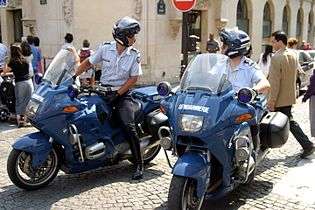


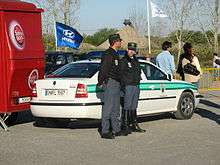
.jpg)
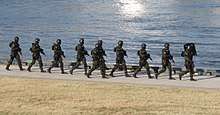
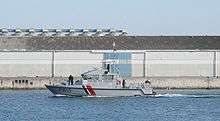
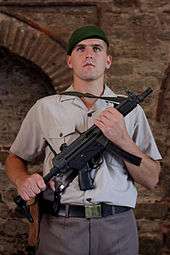
The growth and expansion of gendarmerie units worldwide has been linked to an increasing reluctance by some governments to use military units typically entrusted with external defence for combating internal threats.[1] A somewhat related phenomenon has been the formation of paramilitary units which fall under the authority of civilian police agencies. Since these are not strictly military forces, however, they are not considered gendarmerie.[5]
Some of the more prominent modern gendarmerie organizations include the French National Gendarmerie, Spanish Civil Guard, Argentine National Gendarmerie, Italian Carabinieri, the Royal Netherlands Marechaussee, the Portuguese National Republican Guard and the Turkish Gendarmerie.[5]
Etymology
The word gendarme is a singular extracted from Old French gens d'armes [ʒɑ̃ d‿ aʁm], meaning men-at-arms. During the Late Medieval to the Early Modern period, the term referred to a heavily armoured cavalryman of noble birth, primarily serving in the French army. The word gained policing connotations only during the French Revolution when the Maréchaussée of the Ancien Régime, attached to the Gendarmerie before, by the Monarchy, was renamed, "Gendarmerie".
Historically, the spelling in English was gendarmery, but now the French spelling gendarmerie is more common. The Oxford English Dictionary (OED) uses gendarmery as the principal spelling; Merriam-Webster uses gendarmerie as the principal spelling.
Title and status
These forces are normally titled "gendarmerie", but gendarmeries may bear other titles, for instance the Carabinieri in Italy, the Guarda Nacional Republicana in Portugal, the Guardia Civil in Spain, the Royal Marechaussee in the Netherlands or Internal Troops/National Guard in Ukraine and Russia.
As a result of their duties within the civilian population, gendarmeries are sometimes described as "paramilitary" rather than "military" forces (especially in the English-speaking world where policing is rarely associated with military forces) although this description rarely corresponds to their official status and capabilities. Gendarmes are very rarely deployed in military situations, except in humanitarian deployments abroad.
A gendarmerie may come under the authority of a ministry of defence (e.g. Algeria, Poland), a ministry of the interior (e.g. Argentine, Romania, Ukraine) or even both ministries at once (e.g. Chile, France, Italy, Portugal and Spain).[6] Generally there is some coordination between ministries of defence and the interior over the use of gendarmes.
A few forces which are no longer considered military retain the title "gendarmerie" for reasons of tradition. For instance, the French language title of the Royal Canadian Mounted Police is Gendarmerie royale du Canada (GRC) (i.e., Royal Gendarmerie of Canada) because this force traditionally had some military-style functions (although separate from the Canadian Army) and has retained its status as a regiment of dragoons. The Argentine Gendarmerie is a military force in terms of training, identity and public perception, and was involved in combat in the Falklands War, however it is classified as a "security force" not an "armed force", to exercise jurisdiction over the civilian population under Argentine law.
Since different countries may make different use of institutional terms such as "gendarmerie", there are cases in which the term may become confusing. For instance, in the French-speaking Cantons of Switzerland the "gendarmeries" are the uniformed civil police (see: Gendarmerie (Switzerland)). In Chile, the word "gendarmerie" refers for historic reasons to the prison service (the "Chilean Gendarmerie"), while the actual gendarmerie force is called the "carabineros".
In some cases, a police service's military links are ambiguous and it can be unclear whether a force should be defined as a gendarmerie (e.g. Mexico's Federal Police, Brazil's Military Police, or the former British South Africa Police until 1980). Some historical military units, such as South-West Africa's Koevoet, were only defined as police for political reasons.[7] Services such as the Italian Guardia di Finanza would rarely be defined as gendarmeries since the service is of an ambiguous military status and does not have general policing duties amongst the civilian population. In Russia, the modern National Guard (successor of the Internal Troops) are military units with quasi-police duties but historically, different bodies within the Tsarist Special Corps of Gendarmes performed a variety of functions as an armed rural constabulary, urban riot control units, frontier guards, intelligence agents and political police. Prior to the creation of the Irish Free State in 1922, British rule was based on the Royal Irish Constabulary—a drilled and armed force located in rural "barracks" that was a gendarmerie in all but in name.
In 2014 the Mexican Federal Police, a heavily armed force which has many attributes of a gendarmerie, created a new seventh branch of service called the National Gendarmerie Division. The new force would initially number 5,000 personnel and was created with the assistance of the French gendarmerie.[8]
Role and services
In comparison to civilian police forces, gendarmeries may provide a more disciplined force whose military capabilities (e.g., armoured group in France with armoured personnel carriers) make them more capable of dealing with armed groups and with all types of violence. On the other hand, the necessity of a more stringent selection process for military service, especially in terms of physical prowess and health, restricts the pool of potential recruits in comparison to those from which a civilian police force could select. They also provide a state with flexibility in policing, as the military regulations of a gendarmerie may exempt it from certain gaps in service affecting the civilian police, for example regarding the right to strike.
In countries where the gendarmerie and civilian police co-exist there may be rivalries and tensions between the forces.
In France, the gendarmerie is in charge of rural areas and small towns (typically less than 10.000 inhabitants) which represent 95% of the territory and close to 50% of the population. Besides its territorial organization, it has crowd and riot control units (the Gendarmerie Mobile, along with some corresponding units in the civilian police), counter-terrorism and hostage rescue (GIGN, again along with some corresponding units in the civilian police), maritime surveillance, police at sea and coast guard (Gendarmerie maritime), control and security at airports and air traffic police (Gendarmerie des transports aériens), official buildings guard, honorary services and protection of the President (Garde Républicaine), mountain rescue (Peloton de Gendarmerie de Haute Montagne) and security of nuclear weapons sites.
In Argentina the Gendarmería Nacional Argentina (GNA, Argentina National Gendarmerie) can act as border patrol forces, defending and patrolling the land frontiers, antiterrorism, VIP escort missions, hostage situations and special military operations in war times (when the GNA is attached to the Argentine Army) with their 601st Special Operations Squadron "Alacran", which took part in the Falkland/Malvinas conflict.[9] Also the GNA is responsible for key facilities (such as nuclear facilities) and government building protection and recovery in case of criminal or enemy activities, counter-narcotraffic operations, internal security reinforcement of other provincial and federal security forces, pacification, smuggling control, road controls on federal highways, and counter-sedition activities under martial law.[10] The GNA often take part in UN peace keeping missions.[11]
French influence
The use of military organisations to police civilian populations is common to many time periods and cultures. Being a French concept, the French Gendarmerie has been the most influential model for such an organisation.
Many countries that were once under French rule and influence have a gendarmerie. Italy, Belgium and Austria have had gendarmeries through Napoleonic influence for instance but, while Italy still has the Italian equivalent known as the Carabinieri, Belgium and Austria's gendarmeries have merged with the civil police (in, respectively, 2001 and 2005). Many former French colonies, especially in Africa, also have gendarmeries. The Dutch Royal Marechaussee, was created by King William I to replace the French Gendarmerie after French rule ended.
The national police force of Canada, the Royal Canadian Mounted Police is referred to in French as the Gendarmerie royale du Canada (GRC). However the RCMP is a mainly civilian organisation within Public Safety Canada. It is not part of the Canadian Department of National Defence, but does have a paramilitary wing and they have been awarded the status of a regiment of dragoons, with a military battle standard displaying their battle honours following service in WW1. Those honours include Northwest Canada, South Africa, The Great War and the Second World War.
A common gendarmerie symbol is a flaming grenade, first used as insignia by the French force.
Role in modern conflicts
Gendarmes play an important role re-establishing law and order in conflict areas, a task which is suited to their purpose, training and capabilities.[12][13] Gendarmeries are widely used for internal security and in peacekeeping operations, for instance in the former Yugoslavia[12] and in Ivory Coast,[14] sometimes via the European Gendarmerie Force.[15]
See also
- List of gendarmeries
- National Guard (disambiguation)
- Carabinier
- Security forces
- Paramilitary
- SWAT
- Militia
- Coast Guard
- Militarization of police
- European Gendarmerie Force
- Martial law
References
- Lioe, Kim Eduard (2010-12-03). Armed Forces in Law Enforcement Operations? - The German and European Perspective (1989 ed.). Springer-Verlag Berlin Heidelberg. pp. 52–57. ISBN 978-3-642-15433-1.
- Emsley, Clive (1999). Gendarmes and the State in Nineteenth-Century Europe (1999 ed.). Oxford University Press. pp. 52–57. ISBN 978-0198207986.
- Deep, Daniel (2012). Occupying Syria Under the French Mandate: Insurgency, Space and State Formation. Cambridge University Press. p. 204. ISBN 978-1-107-00006-3.
- Clark, John; Decalo, Samuel (2012). Historical Dictionary of Republic of the Congo. Lanham: Scarecrow Press. pp. 44–49. ISBN 978-0-8108-7989-8.
- Kumar, Kuldeep (2016-04-14). Police and Counterinsurgency: The Untold Story of Tripura's COIN Campaign (2016 ed.). SAGE Publications India. pp. 90–94. ISBN 978-9351507475.
- Lutterbeck, Derek (2013). The Paradox of Gendarmeries : Between Expansion, Demilitarization and Dissolution (PDF). Geneva: Geneva Centre for the Democratic Control of Armed Forces (DCAF). ISBN 9789292222864. SSR Paper 8. Retrieved 8 December 2019.
- Binaifer Nowrojee, Bronwen Manby (1993). Accountability in Namibia: Human rights and the transition to democracy (2001 ed.). Human Rights Watch. pp. 17–20. ISBN 978-1-56432-117-6.
- The Economist, August 23, 2014, pp. 30–31.
- "Gendarmeria Nacional Argentina". gendarmeria.gob.ar. Archived from the original on 2015-04-10. Retrieved 2015-07-01.
- "Gendarmeria Nacional Argentina". gendarmeria.gob.ar.
- "Historia General de las Relaciones Exteriores de la Republica Argentina (Tomo XV)". argentina-rree.com.
- composition of the KFOR
- Giovanni Arcudi, Forces de police et forces armées, sécurité et défense: où sont les frontières?, Cahier du GIPRI, n° 2, pp. 17-64.
- official website of the French Defence Ministry (in French)
- Arcudi, Giovanni; Smith, Michael E. (2013). "The European Gendarmerie Force: A solution in search of problems?". European Security. 22: 1–20. doi:10.1080/09662839.2012.747511.